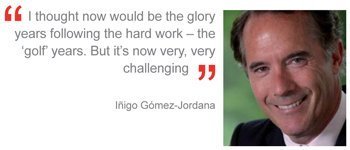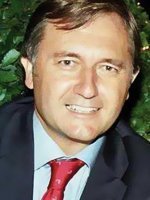Leading the troops in a crisis – Allen & Overy
As law firms battle through the crisis, everyone has to dig in and do their part. While no one can be sure what challenges the future will bring, for Iñigo Gómez-Jordana, Managing Partner of Allen & Overy Spain, striking the right balance between management, leadership and fee-earning is key.
La herencia diplomática y militar puede resultar útil para liderar un despacho de abogados en estos tiempos difíciles. El líder tiene que guiar estratégicamente a su equipo de abogados para que éste pueda lidiar con eficacia las batallas diarias. Iñigo Gómez-Jordana, de abuelo militar y padre embajador, acumula suficientes credenciales para conducir el brazo español del gigante Allen&Overy a través de la actual crisis.
A military and diplomatic heritage could certainly come in handy if you are a law firm leader in the current times. Leading your firm into battle every day and strategising the direction of your army of personnel.
In amongst this, the need for diplomacy and acknowledging that these are indeed tough times, and the troops are people with worries and needs that have to be addressed if they are to fight at their best at work.
With a military grandfather – Francisco Gómez-Jordana Sousa serving in the cabinet of Alfonso XIII – and a Spanish Ambassador for a father, on paper, Iñigo Gómez-Jordana has the right credentials to steer the Spanish arm of UK giant Allen & Overy through the crisis.
“I was meant to be a diplomat actually,” he says. But while in the US for a graduate degree, some New York corporate lawyers derailed this plan, luring him to the world of advocacy. Following a year at Clifford Chance in London, he headed to their offices in Spain, where he joined the ranks of international partnership, before moving to Allen & Overy in Madrid in 2001.
When he joined, A&O had just 20 staff in a small office near the Retiro Park. He remembers a little girl playing outside their offices every day after school. “Which meant I had to take clients to a hotel and let them know the office was being refurbished!” Which it was – just in another building. And three months later they moved into the newly renovated office that they call home to this day.
“It was a very entrepreneurial start,” he jokes.
A late start
A&O’s Madrid office was always intended to mirror that of its other satellites around Europe. But from when he started to today, the office has changed dramatically, says Gómez-Jordana. “The idea was that Madrid was an important place for the firm to have an office, but we came a little late as other well known firms had already arrived – Freshfields and Clifford Chance, for example.”
They were the last, historically, to go in that direction, but they felt confident they had the brand and the international clientele on which to rely, he adds. The driver to finally make the leap into the Spanish market was to serve a long-standing demand from their international network. “I think building on that, we’ve been growing in a very successful and sustainable manner,” he says, with the office going from 20 staff to over 100 today.
A ten-year reflection
Last year, A&O Madrid celebrated its ten-year anniversary in its current home – a long time to reflect on, says Gómez-Jordana. “We had a retreat in Toledo to celebrate, and I compared where we and our competitors were ten years ago and where we all are today – it was illuminating in terms of how consistently we grew, and how dramatically the market has now changed.”
What struck him most was how few international firms were around back then. In 2001, Latham & Watkins, Hogan Lovells and DLA weren’t around, for example – all joining the market over that ten-year period. Some firms grew to service their clients and commensurate to the market, he says, while new entrances came to service the new work.
A&O, however, remains a lean 100-lawyer practice, while a firm like Clifford Chance has grown to almost double that. As one Managing Partner of a competing firm told Iberian Lawyer, while A&O has struggled to grow as big as the others, it may now in fact be closer to the right size for the market than the others.
 Challenging times
Challenging times
Twenty-five years ago, when he started in the profession, Gómez-Jordana never would have expected the legal market or himself to be in the position they are now. “I thought now would be the glory years following the hard work – the ‘golf’ years,” he says. “But it’s now very, very challenging.”
The difficulty is knowing the impact the current Spanish crisis is going to have on the firm and its competitors, he adds, as Spain as a brand is severely damaged, and it’s sending very negative messages to the market. Law firms, both Spanish and international, face challenges on a number of fronts. “The market is shrinking, and the majority of law firms cannot maintain their size,” says Gómez-Jordana, “and if the corporations are reducing manpower, then so must law firms.”
At the start of the crisis in 2009, UK and US firms weren’t shy about making cuts. A&O in the UK cut 450 staff members in a public redundancy programme in the face of the global crisis.
“In Madrid, we didn’t do anything in 2009,” says Gómez-Jordana, “but the market is changing so rapidly and dramatically that I’m not sure what the challenges are going to be, or how we are going to address them. What I can say is that it is going to be a challenge for everyone.”
The reality, he adds, is that it’s a question of quality of business – you need to keep people busy on quality matters, or not . Whether the Spanish will have the same level of transparency when reducing staff as their UK counterparts, however, remains to be seen.
Another challenge is an unpredictable legal environment. There are constant changes in legislation coming up that are going to affect our business, he adds, admitting that adapting to this environment is a challenge in itself. “We need people that are even more technically oriented, with analytical skills as well as the traditional transactional skills. Essentially, we need to be more knowledgeable about the law.”
Getting the best talent is one of the hardest things to manage at the moment. “One of the biggest mistakes you can make is when you hire the wrong person,” says Gómez-Jordana. “But conversely the biggest success for the firm is when you hire the right one.”
These decisions, however, do not land at his feet alone. “We are well supported, and the process for decision-making is collective, so it’s not a crazy guy somewhere hiring and firing at will,” he says, “which has happened in the past”.
He cites Malcolm Gladwell’s ‘10,000 hour rule’. The theory is if you work that long, you become a master at it. “Therefore, factor in 2,000 hours per lawyer per year, we should have genius lawyers in just over four years! But many derail before reaching the 10,000 hours.” The key, he says, is trying to hire the best possible people in terms of potential. “This is our true challenge.”
Lessons from the UK
Being the Spanish arm of an international law firm brings with it some benefits, and challenges, when it comes to sharing know-how. “London is a role model in some areas,” says Gómez-Jordana, “but the problem with having a big organisation in London is the tendency to try to drive your people by their way of operating.”
Gómez-Jordana admits they can be swamped by the number of initiatives and plans coming from across the pond. “But we’re not forced to apply everything here. We learn from London as they are at the forefront of management projects, and they do the thinking. But the challenge is working out how much we can apply here directly.”
As to the differences between the Spanish firms and UK firms, Gómez-Jordana pinpoints one issue: internal structure. “The model of a law firm was not invented in Spain, but came by adapting the methods of Anglo-American law firms,” he explains. “The difference is in the level of transparency and internal structure.” There are some Spanish firms that are almost identical to those in the UK, he adds, but there are others that are the opposite. “The problem is that they all pretend that they are one and the same.”
Stepping back
One client points to what they term as “his strong leadership style”, code perhaps for speaking his mind. But for a Managing Partner, Gómez-Jordana adopts what he calls more of a “hands off” style. Some, he believes, hide behind the title of ‘Managing Partner’, leading and implementing change in isolation, and aren’t involved in fee-earning.
He began as a Co-Managing Partner, but once he took over the role he hired a general office manager to do all those administrative tasks that took him away from fee-earning. “I haven’t reached the level where I have to detach from my work as a lawyer. I have stretched myself to avoid doing so because your clients and lawyers need to see you involved in the day-to-day so they know you can relate to them.”
Within a smaller structure, and with the infrastructural support provided by London, maybe the firm can afford to be management ‘light’. Some, however, would question whether difficult times call for a more ‘management hands on’ approach.
Keeping sane
In challenging times like these, Gómez-Jordana’s inspiration comes from a variety of sources. His love of sports – skiing, running, golf and tennis – foster a spirit of personal endurance that he truly admires in others. “Rafael Nadal, for example, is a real inspiration, the fighting spirit he has.”
He also gets inspiration from people like Churchill: “His ‘We shall fight on the beaches’ speech for example.” Very apt in the current times, and wise words for any law firm leader lacking motivation or drive, or reaching the end of their leadership tether.
Gómez-Jordana paraphrases: “We shall go on to the end…. we shall fight…. we shall never surrender.”
As to the future, he can only add: “We shall see…”












